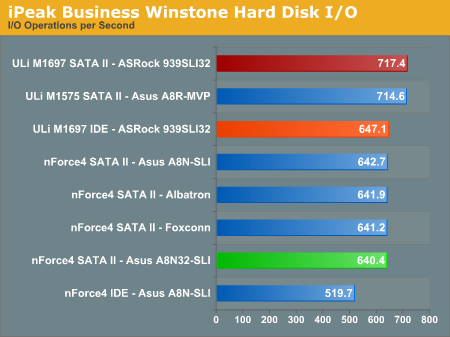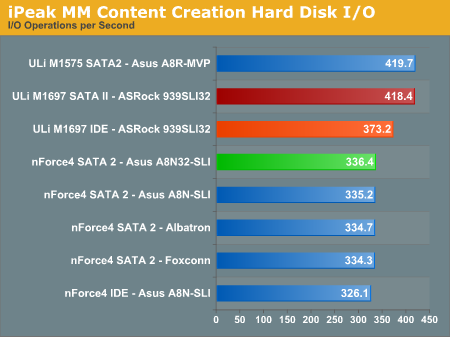ASRock 939SLI32-eSATA2: ULi Dual x16 SLI
by Gary Key on March 2, 2006 12:15 PM EST- Posted in
- Motherboards
Disk Controller Performance
With the variety of disk drive benchmarks available, we needed a means of comparing the true performance of the wide selection of controllers. The logical choice was Anand's storage benchmark first described in Q2 2004 Desktop Hard Drive Comparison: WD Raptor vs. the World. The iPeak test was designed to measure "pure" hard disk performance, and in this case, we kept the hard drive as consistent as possible while varying the hard drive controller. The idea is to measure the performance of a hard drive controller with a consistent hard drive.
We played back Anand's raw files that recorded I/O operations when running a real world benchmark - the entire Winstone 2004 suite. Intel's iPEAK utility was then used to play back the trace file of all I/O operations that took place during a single run of Business Winstone 2004 and MCC Winstone 2004. To try to isolate performance differences to the controllers that we were testing, we used the Maxtor MaXLine III 7L300S0 300GB 7200 RPM SATA drive in all tests. The drive was formatted before each test run and a composite average of 5 tests on each controller interface was tabulated in order to ensure consistency in the benchmark.
iPeak gives a mean service time in milliseconds; in other words, the average time that each drive took to fulfill each I/O operation. In order to make the data more understandable, we report the scores as an average number of I/O operations per second so that higher scores translate into better performance. This number is meaningless as far as hard disk performance is concerned, as it is just the number of I/O operations completed in a second. However, the scores are useful for comparing "pure" performance of the storage controllers in this case.
With the variety of disk drive benchmarks available, we needed a means of comparing the true performance of the wide selection of controllers. The logical choice was Anand's storage benchmark first described in Q2 2004 Desktop Hard Drive Comparison: WD Raptor vs. the World. The iPeak test was designed to measure "pure" hard disk performance, and in this case, we kept the hard drive as consistent as possible while varying the hard drive controller. The idea is to measure the performance of a hard drive controller with a consistent hard drive.
We played back Anand's raw files that recorded I/O operations when running a real world benchmark - the entire Winstone 2004 suite. Intel's iPEAK utility was then used to play back the trace file of all I/O operations that took place during a single run of Business Winstone 2004 and MCC Winstone 2004. To try to isolate performance differences to the controllers that we were testing, we used the Maxtor MaXLine III 7L300S0 300GB 7200 RPM SATA drive in all tests. The drive was formatted before each test run and a composite average of 5 tests on each controller interface was tabulated in order to ensure consistency in the benchmark.
iPeak gives a mean service time in milliseconds; in other words, the average time that each drive took to fulfill each I/O operation. In order to make the data more understandable, we report the scores as an average number of I/O operations per second so that higher scores translate into better performance. This number is meaningless as far as hard disk performance is concerned, as it is just the number of I/O operations completed in a second. However, the scores are useful for comparing "pure" performance of the storage controllers in this case.












46 Comments
View All Comments
Zoomer - Tuesday, March 7, 2006 - link
This board would cannabilize sales of the premium SLI32 and xfire board that Asus sells for $150 IF it included voltage settings up to 2v vCore, 3.2v vMem, etc.They would be stupid to do it. These people will pay the $150 anyway if they don't have an easy (cheap) alternative. For the rest of us, we can get busy with a 2B pencil, solders or conductive ink. ;) And forgo the warranty on it, so if it goes boom in a year's time, you're on your own.
Nice strategy. Would AT leak the beta bios for comparison's sake? (We'll smuggle it to xs or ocwb....:D)
poohbear - Thursday, March 2, 2006 - link
and for the record the dualsata2 is a very stable mobo @ stock settings, i have to give credit where it's due, but for overclocking this company's products shouldnt even be considered.sandorski - Thursday, March 2, 2006 - link
It kinda sucks Nvidia bought out ULI, they were very innovative and really filled niche markets very well. Then again, perhaps Nvidia will let them continue doing interesting things there?Cygni - Thursday, March 2, 2006 - link
Hard to argue with that... looks like ASRock/ULi has another mega seller on their hand with this baby. But I cant help but wish it had an AGP slot thrown in between the two PCI-Ex lanes, to allow an upgrade path. Thats probably the primary reason the ULi 1695 boards have been selling so well.The IDE and SATA performance numbers are really striking in contrast to Nvidia's. I hope we see the inclusion of ULi's storage controller in future Nvidia chipsets.
All for $85... awesome.
Furen - Thursday, March 2, 2006 - link
If it had an AGP slot then it would have to use ULi's AGP tunnel + the 1697 instead of the 1695 + 1697, which would mean that it'd only have 16 PCI-e lanes for graphics. I suppose most of us wouldn't mind going for two 8x slots while in SLI but then most of us wouldn't really want SLI to begin with.JackPack - Thursday, March 2, 2006 - link
Quality doesn't seem to be bad either. Panasonic and UCC caps in there.